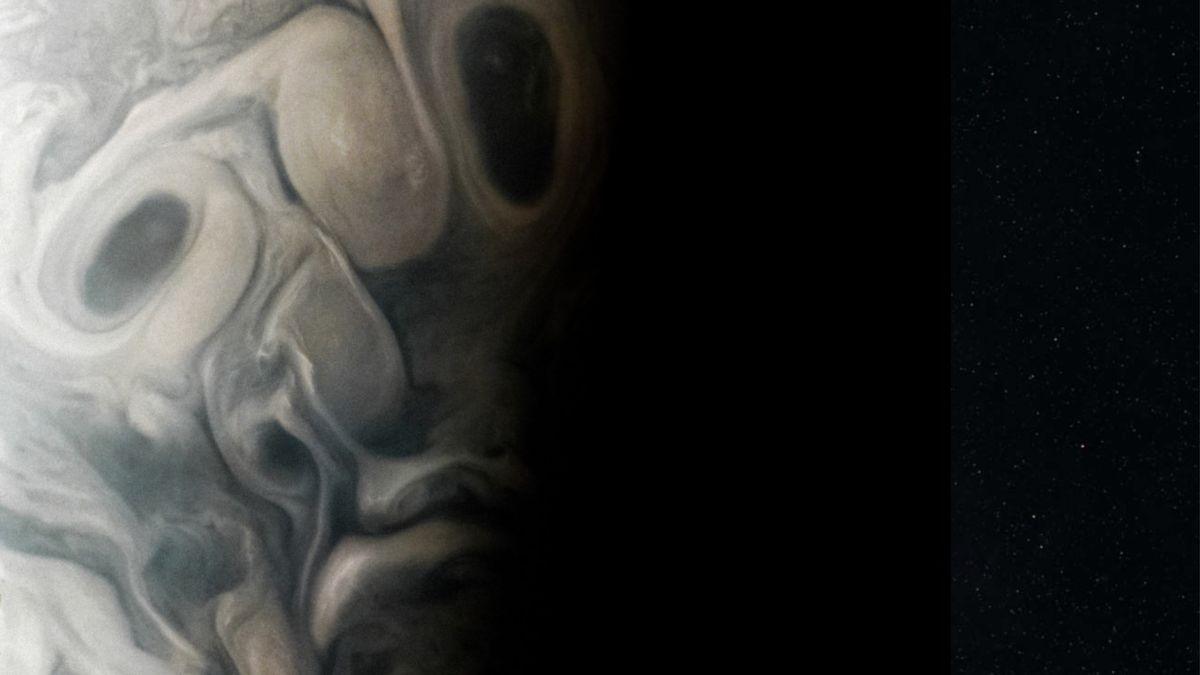Jupiter has a creepy 'face' in haunting Halloween photo by NASA's Juno probe
NASA's Juno spacecraft captured a ghoulish 'face' on Jupiter during a close flyby ahead of Halloween.

NASA's Juno spacecraft captured a ghoulish "face" on Jupiter during a recent flyby of the giant planet, giving us all a nice Halloween treat.
Juno snapped the new image on Sept. 7, capturing a region in the gas giant's far northern reaches that scientists call Jet N7. The area photographed exhibits swirling clouds and turbulent storms resembling an eerie, elongated face, serving as the perfect Halloween costume for Jupiter.
The photo was taken during Juno's 54th close flyby of Jupiter, from an altitude of about 4,800 miles (7,700 kilometers) and a latitude around 69 degrees north. The area photographed lies along Jupiter's terminator — the dividing line between the day and night sides of the planet — which is why the planet appears to fade into the dark background of space, NASA officials wrote in an image description.
Related: How long does it take to get to Jupiter?
NASA released the spooky photo on Oct. 25, just in time to celebrate Halloween. The space agency compared the haunted view to a Cubist portrait, honoring the painter Pablo Picasso in the process.
"We present the @NASASolarSystem image to you on Oct. 25 — what would have been Picasso's 142nd birthday," NASA said in a post on X (formerly known as Twitter).
"The swirling clouds of Jupiter appear to form a frowning human face. Half of the image is in darkness on the planet's night side, almost making the face appear as if it's peering out from behind a door," NASA said in its description of the image shared on Instagram.
Get the Space.com Newsletter
Breaking space news, the latest updates on rocket launches, skywatching events and more!
The image was processed by citizen scientist Vladimir Tarasov using raw data from the JunoCam instrument. Juno's images are available online to the public, who are invited to help NASA comb through the large amount of data collected by the spacecraft.
"The low angle of sunlight highlights the complex topography of features in this region, which scientists have studied to better understand the processes playing out in Jupiter's atmosphere," NASA officials said in the image description.
Swirling clouds are commonly seen on Jupiter due to the planet's turbulent weather systems. Powerful storms in Jupiter's atmosphere fuel fierce jet stream winds that create both cyclones, which circulate clockwise, and anticyclones, which circulate counterclockwise.
From Juno's vantage point, you can just about make out two hollow eyes, a crooked nose and scowling lips in the swirling clouds — almost as if Jupiter were wearing a scary mask for Halloween.
"As often occurs in views from Juno, Jupiter's clouds in this picture lend themselves to pareidolia, the effect that causes observers to perceive faces or other patterns in largely random patterns," NASA officials said in the statement.
Other off-Earth examples of pareidolia are the famous "Face on Mars" and the menagerie of Red Planet "animals" that some internet sleuths think they've uncovered in photos taken by NASA's Curiosity and Perseverance rovers.
Join our Space Forums to keep talking space on the latest missions, night sky and more! And if you have a news tip, correction or comment, let us know at: community@space.com.

Samantha Mathewson joined Space.com as an intern in the summer of 2016. She received a B.A. in Journalism and Environmental Science at the University of New Haven, in Connecticut. Previously, her work has been published in Nature World News. When not writing or reading about science, Samantha enjoys traveling to new places and taking photos! You can follow her on Twitter @Sam_Ashley13.











